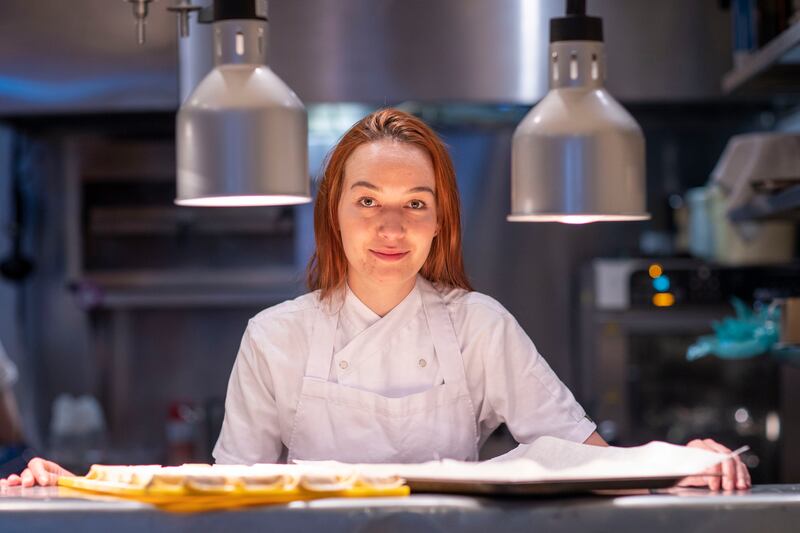Aishling Moore
Head chef, Goldie, Cork
Myth: Washing fish helps remove a “fishy smell”
I have often read and heard that washing fish helps remove a fishy smell. It is actually the opposite. You should never wash fish as it causes the flesh to deteriorate rapidly and encourages that “fishy” aroma. When you buy fish, remove it from the packaging and store it on a plate. Or if you’re lucky enough to have space, store it on a wire rack. Never store fish in plastic – I find it really encourages the fish to sweat and deteriorate much faster.
Mark Treacy
Executive chef, Sheen Falls Lodge
Myth: A soufflé is difficult to make
There are quite a lot of misconceptions around making soufflés, and most people avoid making them, afraid that they won’t rise. In training, I was advised to add a tablespoon of vinegar into a soufflé, which would help with the rising. This isn’t true as the eggs will help it rise anyway. When the soufflé goes in the oven, the air in the whipped egg whites heats up, it expands, and this is what pushes the structure of the mixture up.
Fintan O’Toole: The idiot wind now howling through the US offers Ireland a transformative windfall
The more we learn about smell, the more crucial it proves to our wellbeing
Irish property market is rigged in favour of those who get parental gifts of up to €100,000
What’s the best EV for a 400km round trip without stopping and charging?

Eoin Cluskey
Owner Bread 41, Dublin
Myth: Knocking back dough helps bread rise better
The phrase “knocking back” is open-ended. Is it punching? Is it people being aggressive knocking the air out of it? With sourdough, you could be taking a bread dough out of the fridge 18 hours later. At that stage, what you’re actually trying to do is push the dough back to make it redevelop to build strength in the bread. It should be handled gently from then on in. I just take the bread out of the bowl and gently fold it.

Letícia Miranda
Sous chef, Mae restaurant, Dublin
Myth: All pork must be eaten very well done
People think that all pork must be served very well done. This is a myth that is still very strong today; the reality is that many people refuse to eat a medium-rare piece of pork due to lack of information. It all depends on the quality of the meat you are cooking. Iberian pork, for example, should be cooked medium to medium rare to enjoy the best flavour. Advances in veterinary science and practices have drastically reduced cases of trichinosis. As long as you have top quality meat from reliable producers – and that is critically important – you can get the best out of your pork.
Karl Whelan
Chef
Myth: You have to follow the recipe
For me, the biggest myth in cooking is always follow the recipe. I think when cooking, following the recipe stifles creativity and stands in the way of the evolution of dishes. This, however, is something that you grow into. Cooking can be something you feel, whether it’s sauces, bread, barbecue, whatever. Mastering the basic techniques, for instance, frying, poaching, and braising, is the start of that. Understanding the principles of layering flavours for depth is the key to great cooking.
Roberto Mungo
Chef and owner, Grano, Dublin
Myth: Spaghetti Bolognese is a classic Italian dish
It is a myth that Bolognese sauce is served with spaghetti. I am not sure how this came to be. It should always be served with tagliatelle. In Bologna they are even specific about the size of the tagliatelle. The width of the tagliatelle should be 8mm, which is one twelve-thousandth of the height of the Torre degli Asinelli, the tallest of Bologna’s famous towers. I learned this while training with a sfogline (pasta maker) in Bologna.
Darragh O’Flaherty
Head chef, The Bishop’s Buttery, Cashel Palace Hotel, Co Tipperary
Myth: Meat must be sealed before it’s cooked
I think that one of the biggest cooking myths is that meat must be “sealed” to keep in the juices. The thinking is, if it is first seared at a high temperature, it creates a seal which traps all the juices inside, keeping it tender and full of flavour. What really determines the tenderness and juiciness of steak is the temperature at which it is cooked. So by all means start with a very quick sear, and allow a caramelised crust to form. But after that, bring the temperature right down and make sure that the temperature inside the piece of meat doesn’t get too high.

















